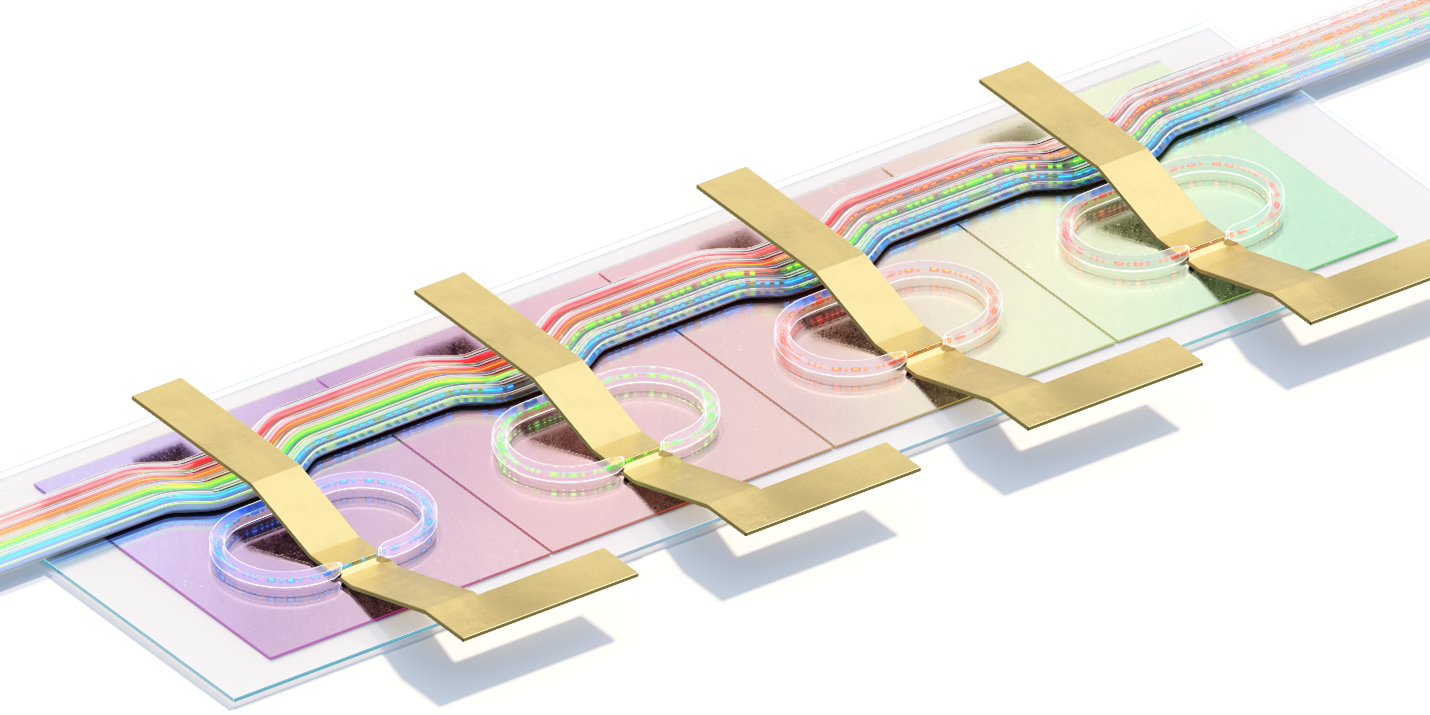Nature Photonics Publication: How resonant modulators supercharge connectivity
A novel optical data transmitter that could make supercomputers and datacenters much more energy efficient has been invented by researchers at ETH Zurich and Polariton Technologies. It allows to simultaneously transmit multiple data streams at high speed and reduces the complexity of the associated controllers.

Transmitting data with light through fiber-optic cables is one of the core technologies of today’s information society. High-performance data centers, communication across oceans and continents, and your internet at home: all rely on transmitting data efficiently from A to B with pulses of light across fiber networks. Key components to generate these pulses from electrical input signals are called modulators. A team of ETH researchers and their industrial partner external page Polariton Technologies have now succeeded in developing a nanostructured modulator design that allows transmitting information at very high speed – and not just for one optical wavelength but with the possibility to scale to multiple wavelengths in the same fiber. Their invention opens possibilities for faster, parallelized optical data transfers within future supercomputers and datacenters and was summarized in the latest issue of the journal external page Nature Photonics.
“In recent years, the computer systems industry has increasingly searched for not only faster speeds but also wavelength-division-multiplexed, parallel data transfers,” says Marco Eppenberger, lead author of the study and researcher in the group of Professor Juerg Leuthold at ETH Zurich. “So far, fast designs were not compatible with multiplexing technologies – or only at the price of quite some complexity. In the new approach, we incorporated plasmonics into a microring cavity modulator. As microring configurations are compatible with simple multiplexing we were able to engineer devices that can do both simultaneously.”
However, the most important part was the fast modulation enabled by the plasmonic approach. In the last decade, Leuthold’s group laid the foundations of plasmonics for data communication, as documented in earlier reports. Their plasmonic technology involves bringing two metals extremely close together, much closer than a fraction of a human hair’s thickness. When confining light between the metals, the light gets highly concentrated to the nanometer scale and can be very efficiently modulated, that is with very little power consumption. This plasmonic modulation technique has now been combined with the more traditional silicon technology. In the traditional silicon approach modulation was obtained with doped silicon. In the new design, the silicon was kept for the guiding and multiplexing of light, but the active modulation section of the circular waveguide was replaced by the plasmonic metal waveguides.
“In fact”, explains Marco, “using plasmonics in a microring cavity is mutually beneficial: the cavity allows to reduce the plasmonic’s losses whereas the plasmonics allow pushing the cavity’s speed limits to much higher values. With the proper design, we were even able to demonstrate a new world record in data transmission speeds!”
For achieving the light-modifying effect in the plasmonic section, the researchers inserted a nonlinear polymer between the two metal electrodes, rather than relying on silicon. Adding the polymer was found to bring another important advantage: it improves the temperature tolerance of the modulator - a very important property for an application in supercomputing. “So far,” says Marco, “complex thermal stabilization systems had to be implemented when using previous designs close to processors, as processors tend to rapidly change their temperature under operation. With the higher temperature tolerance, the thermal stabilizers could be simplified or even completely omitted.”
The newly invented modulator designs are expected to be useful for interconnecting the different processors in supercomputers or data centers. Fast and thermally stable transmitters can be tightly co-integrated with the processors and memories, which ultimately serve nothing else but one goal: To make connectivity as energy efficient as possible.
References to publication:
- external page https://www.nature.com/articles/s41566-023-01161-9
- DOI number of paper: 10.1038/s41566-023-01161-9